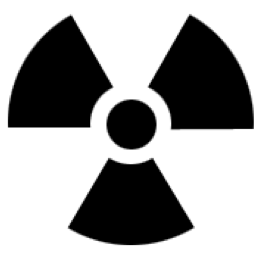Alara
§20.1101 Radiation protection programs. The radiation protection program ensures compliance with regulations. Its goal is to ensure that doses to workers and members of the public are as low as reasonably achievable (ALARA) below state and federal limits.
Dose Limits
§20.1201, §20.1207, §20.1208, and §20.1301. Dose limits for workers and the public. Dose limits have been established for adult workers, minor workers, declared pregnant women, and members of the public. The limits are in Table 2.1.
| Whole body dose in one year | Other limits | |
|---|---|---|
| Adult workers | 5 rem | Lens 15 rem each year. Skin, organ, extremities in one year: 50 rem |
| Minor workers | 10% of Adult Limit | 10% of Adult Limit |
| Declared pregnant woman | 0.5 rem fetal dose | 50 millirem fetal dose each month. Skin, lens, extremities: same as adult worker |
| Members of the public |
0.1 rem | 2 mrem in one hour |
Table 2.1 DOSE LIMITS FOR ADULT WORKERS, MINOR WORKERS, DECLARED PREGNANT WOMEN, AND MEMBERS OF THE PUBLIC. The dose is the sum of the body dosimeter deep dose plus internal effective dose equivalent from ingested or inhaled radionuclides. Internal dose is uncommon in the institutional setting. Our goal is to keep radiation dose below 10% of these limits.
Surveys
§20.1501 Surveys. Surveys must be made to demonstrate compliance with the regulations and to evaluate the potential for radiological hazard that may be present.
Security
§20.1801 Security of stored material. Radioactive material in controlled or unrestricted areas must be secured from unauthorized removal.
Radiation Symbol
§20.1901. Caution signs. The standard radiation symbol appears in Figure 2.1. It is magenta, purple, or black on a yellow background.

FIGURE 2.1 RADIATION SYMBOL. It is magenta, purple, or black on a yellow background.
Posting Requirements
§20.1901 and §20.1902 Posting requirements. The appropriate posting depends on the dose rate or amount of radioactivity in the area or container. Thresholds are provided in TABLE 2.2.
| Condition | Posting |
|---|---|
| 5 mrem in 1 hour at 30 cm from the source or shield surface | Caution, Radiation Area |
| 100 mrem in 1 hour at 30 cm from the source or shield surface | Caution, High Radiation Area |
| 500 rads in 1 hour at 1 m from the source or shield | Grave Danger, Very High Radiation Area |
| Air concentrations exceeding the DAC in Quantities of Licensed Material Requiring Labeling. | Caution, Airborne Radioactivity Area |
| Use or storage of ten times the quantity in Quantities of Licensed Material Requiring Labeling. | Caution, Radioactive Material |
TABLE 2.2 POSTING REQUIREMENTS. DAC means derived air concentration. See Quantities of Licensed Material Requiring Labeling.
Labeling Requirements
§20.1901, §20.1904, and 20.1905 Labeling requirements. Containers with greater than Quantities of Licensed Material Requiring Labeling must be labeled with the radiation symbol, the words “Caution, Radioactive Material,” and appropriate precautionary information such as radionuclide, activity, date, dose rate at a specified distance, and chemical form.
Package receipt, opening, and disposal of empty containers
§20.1906 Receiving and opening packages. All non‐clinical radioactive materials must be shipped directly to the Health Physics Inspection Station (See Part 3 Ordering and receiving radioactive material for further information). After delivery to the laboratory, review the safety instructions provided by Health Physics and inspect the package for leakage and correctness of contents. If a package appears damaged, promptly contact Health Physics and monitor for dose rate and contamination. If certain thresholds are exceeded, Health Physics must notify the carrier, the Department of Public Health and the Nuclear Regulatory Commission.
If you receive material directly and it has not been inspected, inform Health Physics promptly, and if requested, bring the package to the Inspection Station.
Before discarding empty containers and shipping packages, survey them to ensure that they are not contaminated. Then remove or deface all radiation labels and words. This assures that if the package gets out of the house waste stream it will not be mistaken for a radiation source.
Waste
§20.2001, §20.2003, §20.2005 Waste disposal. Radioactive waste can only be disposed of by transfer to a waste contractor, decay‐in‐storage, release in effluents, or discharge to the sanitary sewer
Records
§20.2101 Units. Records must have measures recorded in units or multiples of curie, rad, and rem (e.g., mCi, dpm).
Reports
§20.2201, §20.2202, §20.2203 Reports and notifications. Certain types of events require prompt reporting to regulatory authorities. If there is a theft, loss, more than a minor spill, accidental release, or injury involving radioactive material, report it promptly to Health Physics.
Precaution
When making an event report, do not simply leave a recorded message or a note on someone’s door. Talk with a member of Health Physics or EH&S, your project director, or the department chair. This assures that there will be prompt, appropriate follow‐up.
